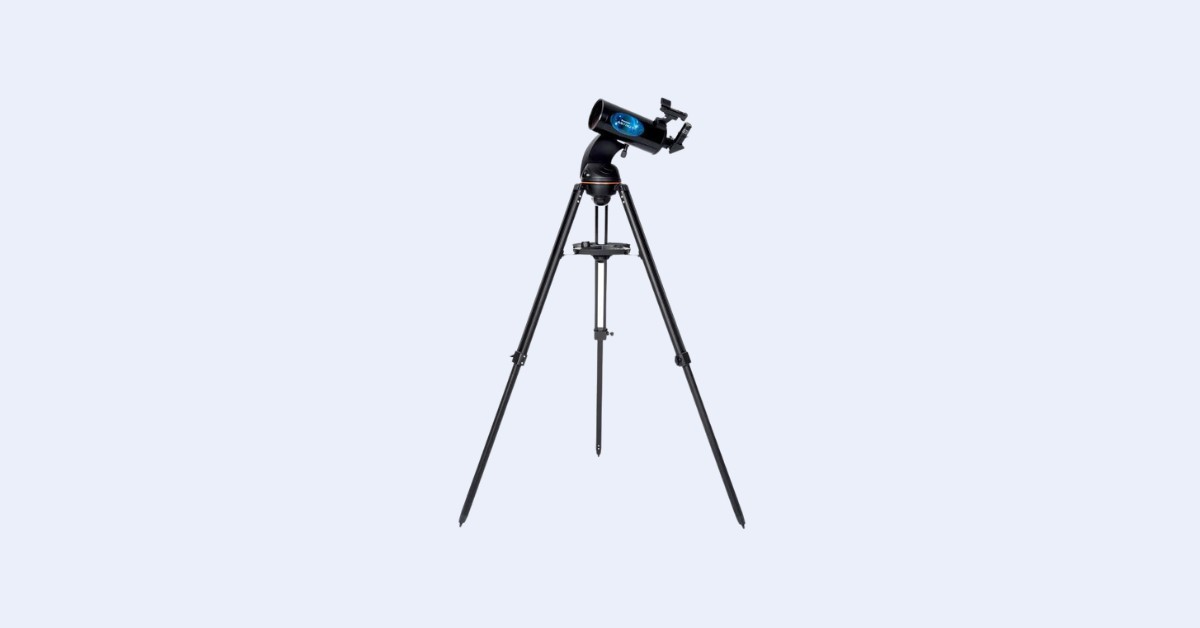The Optical Tube’s Performance and Features
The Celestron Astro Fi 102 is a 4” (102mm) aperture Maksutov-Cassegrain type of telescope with a focal length of 1325mm and focal ratio of f/13.
Maksutov-Cassegrains are known for having sharp optics, and I can confirm to you that the Astro Fi 102 lives up to that promise. On a clear, steady night, I could see great views of the moon and planets all the way up to the telescope’s theoretical limit of 200x magnification. At f/13, even the cheapest from my eyepiece collection works fairly well, with little to no edge-of-field distortion at low magnification views.
Maksutov-Cassegrain telescopes don’t really need to be collimated. But if they do, the Astro Fi 102 has adjustments for collimation behind its primary mirror.
Focusing the Astro Fi 102 is accomplished by turning a knob at the back of the telescope’s optical tube, which adjusts the spacing of the primary mirror with respect to the secondary mirror inside the telescope’s tube. This can result in a minor “image shift” during focusing, but it is not a huge problem for me.
The back of the optical tube also has proprietary threads with a 1.25” visual back provided to hold a 1.25” star diagonal. The visual back also has T-threads to directly screw on a DSLR camera with a suitable T-ring if I need to.
The Astro Fi 102 optical tube attaches directly to its mount with a Vixen-style dovetail bar, which allows it to be used with a variety of other astronomical mounts as well as attached to a photo tripod if I wish.
The Decent Set of Accessories
The Celestron Astro Fi 102mm Maksutov-Cassegrain comes with a 1.25” prism star diagonal, which slots into the provided 1.25” visual back, and two 1.25” Kellner eyepieces: a 25mm for 53x magnification and a 10mm for 133x.
From my usage, these were both decent eyepieces with all-metal housings and glass lenses. I noted that they lack eyeguards, and the 10mm is also a little short on eye relief. But I like that its apparent field of view of around 50 degrees is sharp and not lacking in contrast.
For a finder, the Astro Fi 102 includes Celestron’s standard, generic “StarPointer” red dot finder, which is primarily used to line up the telescope with alignment stars during setup. It attaches with a standard interchangeable Synta/Vixen-style foot, so you could swap in a different finder if you wish, but I don’t see much point in doing so.
The Decent Smartphone-Controlled Mount
The Celestron Astro Fi mount is an improved version of the Celestron’s older NexStar SLT and GT mounts and is similar to the Celestron SkyProdigy mount, which also has SLT design heritage.
The mount is a simple GoTo alt-azimuth mount that can hold up to a 5-inch telescope. Compared to the NexStar SLT, it has better gears and a sturdier tripod, with extruded aluminum legs instead of the SLT’s too-small tubular steel legs.
The accessory tray has plenty of room for eyepieces, flashlights, or our smartphone; one half has slots for the provided 1.25” Kellner eyepieces, and the other is covered in grippy stuff and has a well to put your smartphone in. This is much better than the annoying and largely useless eyepiece holders that I’ve often seen come with beginner telescopes as an accessory tray.
The Astro Fi mount is completely unsuitable for deep-sky astrophotography, of course (as is a 102mm f/13 Maksutov optical tube), but it works quite well for visual astronomy.
I personally power the Astro Fi mount with a set of standard batteries and the external plug-in battery pack, or I plug in another external power source. I would recommend that you get a rechargeable power supply as soon as you can to save money and for better reliability.
Setting up the Astro Fi mount is quite simple. After turning on the telescope and leveling the tripod, I connect to its WiFi network and open either Celestron’s SkyPortal app or SkySafari Pro on my smartphone/tablet. The app will guide me through centering and confirming a few alignment stars. Afterwards, I’m free to slew the telescope around the sky with push-button controls on my screen or select from a huge database of objects that the telescope will automatically point at and track for me.
There are some unseen bonuses here that I should mention besides the easy interface of a screen versus an old-fashioned keypad.
The telescope can get precise location and time information from my phone rather than relying on expensive internal GPS and clock units or me entering that information myself. If I walk away and my device disconnects from the Astro Fi’s WiFi network, the telescope keeps tracking and remembers its alignment information once I reconnect.
Should I buy a Used Celestron Astro Fi 102?
A used Astro Fi 102 should be fine, but older units tended to suffer from reliability issues with the WiFi network maintaining a connection to a device, which could be a problem. If you’re buying one that wasn’t purchased recently and the owner didn’t use it successfully, that could be a red flag.
Price is also a concern; as with any electronic device or telescope, don’t pay too close to the new price for a used unit, especially since it will probably be without a warranty or any guarantees as to condition or the ability to get a refund.
Maksutov-Cassegrain telescopes are pretty hard to damage, but as usual, check to make sure that the optics are not damaged and are free of corrosion or fungus.
Alternative Recommendations
The price of the Celestron Astro Fi 102 is about the same as that of many 5″ and 6″ manual and GoTo telescopes. For a little more, you could also get an 8” or 10” Dobsonian. Any of these options will be much better for viewing than the small aperture of the Astro Fi 102.
Under $500
- The Sky-Watcher Virtuoso GTi 150P has fully motorized GoTo and tracking controlled via your smartphone or tablet, in addition to a significantly larger aperture and a much wider field of view than the Astro Fi 102. It can also be aimed manually with no ill effect on the GoTo alignment and compacts into an extremely small package thanks to its collapsible tube. A 130mm model is also available.
$500-$700
- The Apertura AD8 offers double the aperture—thus twice the resolution and 4x the light gathering ability—of the Astro Fi 102, along with a pile of useful accessories and features mounted atop a sturdy and simple Dobsonian mount.
- The Celestron Astro Fi 130 uses the same mount and includes the same accessories as the Astro Fi 102, but the 130mm f/5 Newtonian optical tube has quite a bit more light gathering and resolving power and offers a drastically wider achievable field of view, more suited for viewing deep-sky objects than the 102mm Maksutov.
Aftermarket Accessory Recommendations
The Celestron Astro Fi 102’s included star diagonal and eyepieces are just fine, but you may want a few more oculars for additional magnification. A 32mm Plossl eyepiece will provide 41x magnification and a slightly wider true field of view than the Astro Fi’s stock 25mm Kellner eyepiece. A 15mm SWA or redline eyepiece will produce 88x magnification with the Astro Fi 102, bridging the gap between the stock 25mm and 10mm oculars.
A dew shield for the Astro Fi 102 is also a must. It will prevent condensation from forming on your telescope’s front corrector plate and also act as a lens hood, lessening glare from nearby light sources such as street lamps or the Moon.
Observing with Celestron Astro Fi 102
The Astro Fi 102’s long focal length, small aperture, and 1.25”-only eyepiece capabilities make it severely limited when it comes to viewing deep-sky objects. The Astro Fi 102 lacks the ability to fit huge open clusters or the largest nebulae in the field of view at all and is too small to resolve globular star clusters or most planetary nebulae as anything more than smudges.
I could see galaxies like Andromeda and the many galaxies making up the Virgo Cluster from decent skies, but I didn’t expect much; a few galaxies like M82 show traces of detail like dust lanes, however. The brightest nebulae like the Orion Nebula (M42) still dazzle, and many open clusters do still fit in the field of view, such as M35, but a larger telescope shows them better.
The Astro Fi 102 does pretty well on the Moon and planets, however.
- Expect to have no trouble seeing the phases of Mercury and Venus, along with the ice caps on Mars.
- Mars shows some dark markings with the Astro Fi 102 on a steady night when it is at its closest to Earth.
- The Moon delights with thousands of details like craters, ridges, and mountains.
- Jupiter’s cloud belts and Great Red Spot can also be seen; the disks of the four large Galilean moons, along with their shadows, can be resolved by the Astro Fi 102 when they transit in front of the planet.
- Saturn’s rings and the Cassini Division within them can also be glimpsed, along with cloud belts on Saturn and a few moons.
- Uranus is resolved as a fuzzy bluish-green ball.
- Neptune is hard to distinguish from a star, and its moons are too dim to see with only 4 inches of aperture.
- Pluto is also too dim to see with such a small instrument.




Nice review. Do you know what the actual thread size is on visual back is on the Astro fi 102 Mak scope? can you get a adapter for it for SCT stuff? do you know? you said standard but what is standard it seems there are all kinds of sizes for Maks….thanks
M44.5 https://agenaastro.com/blue-fireball-sct-thread-adapter-maksutov-cassegrain-telescope.html